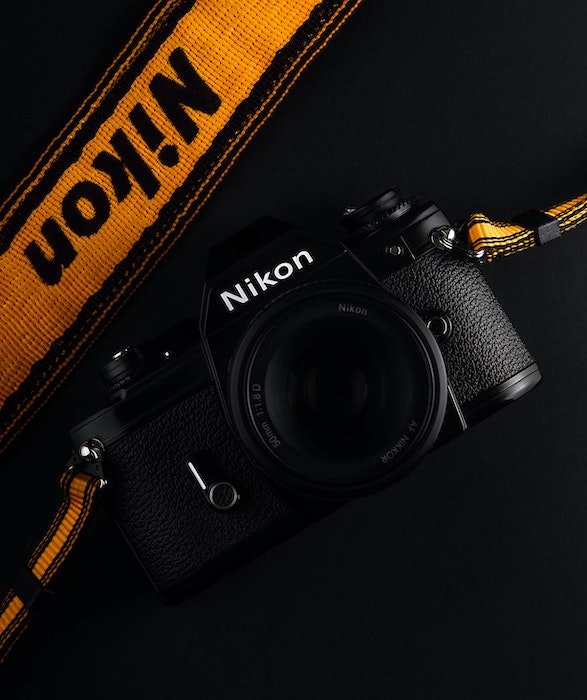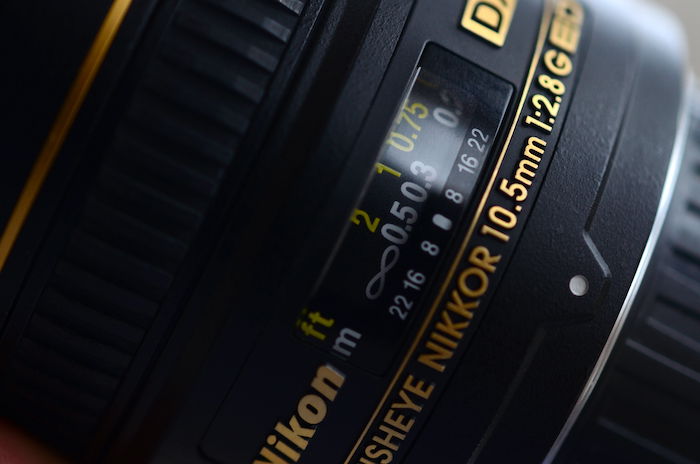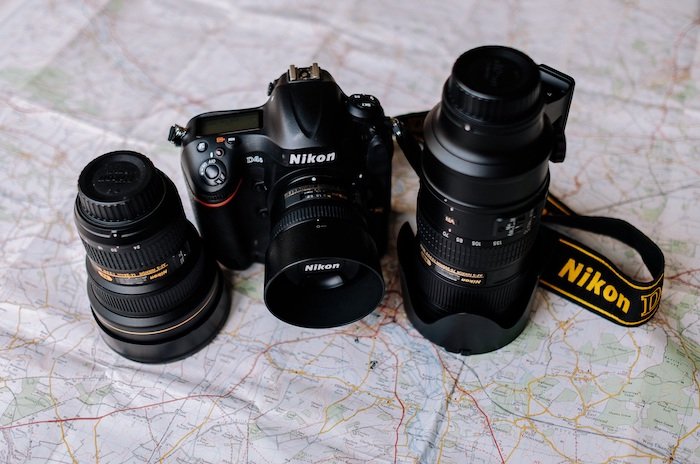
To find out the features of your Nikon lens, you can check out the lens manual or read abstracts around the lens. The alphabetical order you find may seem more like hieroglyphics than useful clues.
We have broken them down a list to get a solid idea of what each set of characters means at the end. Don’t worry too much about memorizing, as you can always return to this list as a reference.
flat image of a black Nikon camera with a bright orange band on a black background
[Note: Expert Photography is supported by students. Product links in Expert Photography are referral links. If you use one of these and buy something, we make less money. Need more information? See how it all works here.]
Lens summaries are a set of initials usually found behind a focal point in the lens. You can find these shots printed on your lens bin. The initials will give you information about the properties and features of that particular lens.
These features include its autofocus drive, stabilization properties, and many more.
Let’s look at an example.
Nikon AF-S NIKKOR 120-300MM F / 2.8E FL ED SR VR.
As you can see from the lens of the lens, there is information that you may be familiar with — the fixed width and the opening number. The whole set of summaries is also in the title, however.
In this example, we combine AF-S, FL, ED, SR and VR. I can tell you that the lens can focus automatically and has the ability to reduce vibration from this information. I would also say that there is a very low scattering and fluorite material used in the lens and a lens element that distorts the UV rays.

Now you see that you can find valuable information in these summaries. Let’s dive deeper into the concepts you will encounter in your Nikon lens.
A – Manual focus lens. Found in the original bayonet lens since 1959. It is considered pre-AI.
ADR – Direct (A) hole (D) reading (R). This summary occurs as some Nikon lenses have a hanging prism that closes lens opening numbers. This was used in AI lenses in 1977.
AF-I – An autofocus lens (AF) with integrated (I) engine, which is not very focused. AF-I lenses are type D lenses. However, some older film organizations cannot automatically focus on them either.
AF-P – Autofocus lens (AF) with special printing presses. This default feature went live in 2015. We need a digital body with the latest firmware.
AF-S – An autofocus (AF) lens with a compact (S) wave coating, not too focused. It is a standard autofocus function for Nikon lenses.
AI – Default (A) indicator to open the top position (I). This is a mechanical device for attaching the lens to a camera exposure system. This is for hand-focused cameras and was launched in 1977.
AI-P – A variation of AI function. The lens has a built-in CPU that transmits meter data from the lens to the camera.
AI-S – Another variation of AI function. Designed to be used with shutter priority (S) exposure methods. This was made for hand-focused focus lenses.
ASP – This will have an aspherical lens (AS) feature in its visual design. Asherical lenses use complex curves to create lens elements to eliminate lens distortion and more.

C – Type of adhesive lenses for pre-AI lenses. Nikon coating integrated.
CRC – Close (C) range (R) correction (C).. This lens is designed to provide better focus on nearby distances.
CX – Nikon 1 camera lens without mirrors. This was introduced to the market in 2011.
D – It means that the lens adds distance (D) information to the data transferred to the body of camera.
DC – Defocus lens (D) control (C). This allows the photographer to adjust the degree of circular rotation in nonlinear areas.
DX – This is a standard abstract lens designed for cameras with small frames. DX lenses are for DSLR’s but can operate 35mm more bodies.
E – Electronic (E) aperture activation. This will mean that your lens does not have a physical connection to the camera’s opening position. Instead, it will use an electronic signal between the camera and the lens to control the entry point.
ED – Additional (E) low scattering material (D) is in this lens.
Fluids of FL – Fluorite (FL) are in this lens. Fluorite elements have a lighter weight than ordinary glass.
FX – 35mm full frame sensor lens. This refers to the power of the lens to cover the sensor of Nikon FX.
G – This will be the lens without the ring opening. You will need to control this internal camera.
HRI – High (H) refractive (R) index (I). A single HRI lens can give the same effect as a few standard glass objects. This is directly related to field curvature and spherical aberrations.

Nikon Lens Summary: A Nikon camera with two additional lenses on the map
IF – Lenses use internal (I) focusing (F) rather than alter the elements of external lenses.
IX – A lens designed for the Pronea system.
N – Nano (N) adhesive. This lens will incorporate crystalline coating that eliminates the resistance of the lens element. This combination reduces ghosting and flare problems.
NIC – Nikon (N) compact (I) adhesive (C). The lens will feature a Nikon glass coating system that helps reduce rashes and ghosts.
PC – Watch lens (P) control (C). This means you can change the front of the lens to adjust the viewing angle.
PF – Category (P) fresnel (F). A type of diffraction optic that makes small lenses.
RF – Back (R) focus (F). This means that the lens focuses on moving its rear elements.
S-line – Top lens (S). Found in the Nikon mirrorless Z series.
SIC – Super (S) Combined (I) wear (C). It is usually found in complex zoom lenses.
In this list, we can see the importance of knowing these Nikon lens abbreviations. Every piece of technology that Nikon develops in its lenses will probably be summed up and shown in the lens bar. It is a great way to show off its features and add to the lens of the lens, almost like a military veteran showing his respect.
Now that you know what it all means, go with your lenses to get their qualities. Who knows, maybe there is a factor that leads you to explore a new style of photography.
Monday – Saturday:
11:30 AM – 9pm
Copyright © 2025. All Rights Reserved.
Website Powered By DABBS Solutions Pvt. Ltd.
Social Chat is free, download and try it now here!